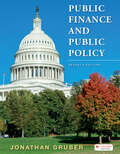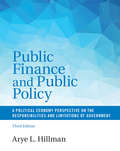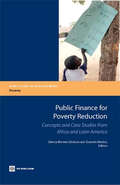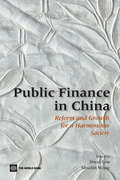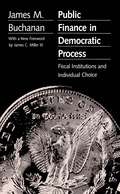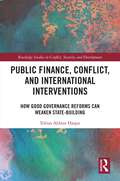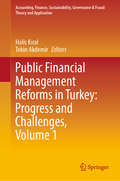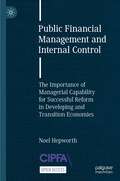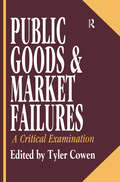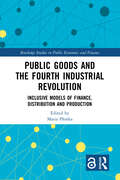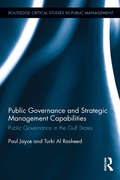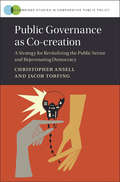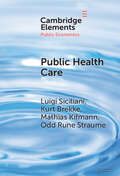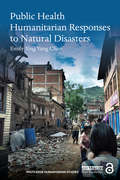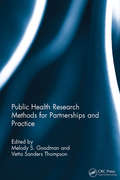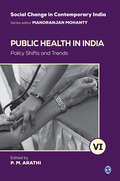- Table View
- List View
Public Finance and Public Policy
by Jonathan GruberFrom an original architect of The Affordable Care Act, an up-to-date look at public finance and policy, especially in how they have been impacted by COVID.
Public Finance and Public Policy: A Political Economy Perspective on the Responsibilities and Limitations of Government
by Arye L. HillmanThis new edition restructures and updates the political economy view of the responsibilities and limitations of government. Public-choice and behavioural concepts are prominent. Gender issues are included. Technical concepts are explained from first principles. Economic theory is rigorously applied. Excessive technicality is avoided. The book integrates traditional public finance topics - taxation, public goods, externalities, and income redistribution - with political self-interest, bureaucracy, voting, rent seeking, corruption, and the common-pool problem of public spending. Social justice is viewed as income equality, equality of opportunity, or the right to benefit from one's own effort. Public policies studied include the environment, education, health insurance, welfare payments and entitlements under moral hazard, unemployment insurance, paternalistic impositions, and defence and public safety. This book is ideal for advanced undergraduate and graduate courses that combine economic theory with a real-world perspective on the politics of public finance and public policy. A broad scope makes the book suitable for students in all countries.
Public Finance for Poverty Reduction
by Blanca Moreno-Dodson Quentin WodonThis book presents some basic theoretical concepts of public finance with a particular emphasis on its impact poverty reduction. Eight case studies from Latin America and Africa illustrate how these concepts are applied in practice and the implementation issues that emerge.
Public Finance in China
by Jiwei Lou Shuilin WangSince 1980, China's economy has been the envy of the world. Is annual growth rate of more than 9 percent during this period makes China today the world's fourth-largest economy. And this sustained growth has reduced the poverty rate from 60 percent of the population to less than 10 percent. However, such rapid growth has also increased inequalities in income and access to basic services and stressed natural resources. The government seeks to resolve these and other issues by creating a 'harmonious society' -- shifting priorities from the overriding pursuit of growth to more balanced economic and social development. This volume compiles analyses and insights from high-level Chinese policy makers and prominent international scholars that address the changes needed in public finance for success in the government's new endeavor. It examines such key policy issues as public finance and the changing role of the state; fiscal reform and revenue and expenditure assignments; intergovernmental relations and fiscal transfers; and financing and delivery of basic public goods such as compulsory education, innovation, public health, and social protection. And it offers concrete recommendations for immediate policy changes and for China's future reform agenda. 'Public Finance in China' is a must-read for specialists in public finance and for those seeking an understanding of the complex and daunting challenges China is facing.
Public Finance in Democratic Process
by James M. BuchananStudies of public finance, as traditionally developed, have analyzed the effects of fiscal institutions on the market-choice behavior of individuals and firms, but this book takes a different approach. It analyzes the effects of fiscal institutions on the political-choice behavior of individuals as they participate variously in the decision-making processes of democracies.What effect will the form of a new tax have on individuals' attitudes toward more or less public spending? To what extent does the private sector--public sector mix depend on the way in which tax payments are made? How do the various taxes affect the fiscal consciousness of individual citizens? These are questions that have been ignored for the most part. They are, nonetheless, important and worthy of examination. This book is an attempt to provide some provisional answers. By the use of simplified models of existing tax institutions, Buchanan predicts the effects that these exert on individual behavior in the area of political choice. The relative effects of direct and indirect taxes, the "old tax--new tax" distinction, the effects of fiscal earmarking, the effects of unbalanced budgets -- these are a few of the topics examined.Before these questions can be fully answered, research must be conducted to find out just how much individuals know about the taxes they pay and the benefits they receive. Comparatively little research of this kind has been completed, but the author devotes a chapter to a careful review of the present state of this sort of research.Individuals' choice among alternative fiscal institutions is examined in the second part of the book. If given the opportunity, how would the individual choose to pay his or her taxes? Progressive income taxes, excise taxes, and public debt are analyzed in terms of this question. Because of its interdisciplinary approach, this imaginative study will be of interest to both economists and political scientists.
Public Finance in Theory and Practice Second edition
by Holley H. UlbrichThe events of the last decade have challenged the contemporary neo-classical synthesis in all branches of economics, but particularly public finance. The most notable feature of the 2nd edition of Public Finance in Theory and Practice is the infusion of behavioral economics throughout the text, with an end of chapter question inviting the student to apply a behavioral lens to some question or issue. There continues to be an emphasis on the importance of the institutional context, drawing on examples from many countries and emphasizing the role of lower level governments in a federal system. The first five chapters establish this context by reviewing the role of government in a market system, the description of government structure from an economic perspective, the basic data about revenue and expenditures, the elements of public choice, and the distributional role of government. The book has been substantially reorganized to put more emphasis on public expenditure. Expanded treatment of public goods includes common property resources and congestible or club goods. Expanded discussion of budgeting and cost-benefit analysis provides some practical application of the theory. Updated discussions of social security, public education and health care address these three major contemporary public finance issues. The traditional emphasis on revenue (taxes, fees and grants) has been retained but follows rather than precedes the discussion of expenditures.
Public Finance with Behavioural Agents (Elements in Behavioural and Experimental Economics)
by Raphaël LardeuxRecent developments in behavioural economics have deeply influenced the way governments design public policies. They give citizens access to online simulators to cope with tax and benefits systems and increasingly rely on nudges to guide individual decisions. The recent surge of interest in Behavioural Public Finance is grounded on the conviction that a better understanding of individual behaviours could improve predictions of tax revenue and help design better-suited incentives to save for retirement, search for a new job, go to school or seek medical attention. Through a presentation of the most recent developments in Behavioural Public Finance, this Element discusses the way Behavioural Economics has improved our understanding of fiscal policies.
Public Finance, Conflict, and International Interventions: How Good Governance Reforms Can Weaken State-building (Routledge Studies in Conflict, Security and Development)
by Tobias Akhtar HaqueThis book provides a critical analysis of the political and conflict impacts of “good governance” public finance reforms, showing how unintended distributional outcomes can undermine broader state‑building goals.The international community expends enormous resources trying to build “good governance” institutions in countries emerging from war. By ensuring efficiency, increasing transparency, and enhancing public accountability in the use of public resources, the adoption of “good governance” institutions is assumed to support stability, peace, and sustainable economic growth. Such assumptions, however, have a limited empirical basis and obscure a more complex reality. Drawing from political science and institutional economics, and evidence from major state‑building interventions in Afghanistan, Timor‑Leste, and Solomon Islands, this book explores the impacts of technocratic “good governance” reforms in fragile environments. Through the lens of public finance reform, it illustrates how efforts to achieve efficiency and accountability, while often bringing important benefits, can also undercut the patronage channels that draw together powerful elites, thereby increasing conflict pressures and eroding prospects for sustainable peace. This book makes the case for a reconsideration of the “good governance” agenda and the appropriateness of its application in developing countries experiencing or at risk of war.This book will be of interest to students of state‑building, global governance, political economy, development studies, and International Relations.
Public Financial Management Reforms in Turkey: Progress and Challenges, Volume 1 (Accounting, Finance, Sustainability, Governance & Fraud: Theory and Application)
by Halis Kıral Tekin AkdemirThis book provides an assessment of public financial management (PFM) reforms in developing countries using Turkey as a case study. The book elaborates on revenue management, expenditure management, public budget, public financial management information systems, asset and liability management, intergovernmental fiscal relations, accounting, financial reporting, and auditing. Bringing together academics and practitioners, the book analyzes the PFM reforms in the light of theoretical explanations and practices to reveal the achievements, challenges, and future perspectives of PFM.
Public Financial Management Reforms in Turkey: Progress and Challenges, Volume 2 (Accounting, Finance, Sustainability, Governance & Fraud: Theory and Application)
by Halis Kıral Tekin AkdemirThis book provides an assessment of public financial management (PFM) reforms in developing countries using Turkey as a case study. Volume II elaborates on asset and liability management, intergovernmental fiscal relations, accounting, financial reporting, and auditing. Bringing together academics and practitioners, the book analyzes the PFM reforms in the light of theoretical explanations and practices to reveal the achievements, challenges, and future perspectives of PFM.
Public Financial Management and Fiscal Outcomes in Sub-Saharan African Heavily-Indebted Poor Countries
by Tej Prakash Ezequiel CabezonA report from the International Monetary Fund.
Public Financial Management and Internal Control: The Importance of Managerial Capability for Successful Reform in Developing and Transition Economies
by Noel HepworthThis open access book focuses on the ‘downstream’ element of PFM, that is how public organisations utilise public resources. It argues that improvements in PFM/IC will only flow from a recognition that what really matters is the quality of management. Management reform is an essential precondition to the successful implementation of many new techniques. Only when a managerial capacity exists willing to take advantage of the opportunities created by such technical developments, is it beneficial to pursue them. The benefits of PFM/IC flow from an improved quality of management.Despite enormous efforts, reform of public financial management and internal control (PFM/IC) in developing and transition economy countries has not been particularly successful in improving the quality of public service delivery and the use of public resources. This book outlines why this is and suggests a new approach. The analysis set out in this book is particularly relevant especially given limited national budgets and squeezed international aid budgets. These management changes include to the political/official relationships, to management structures, to budgetary and accounting arrangements and to the relationships between, particularly, the ministry of finance and other ministries. They require the delegation of operational management, developments in financial management and in accountability arrangements and a reconsideration of personnel policies, penalty and sanction arrangements. Managerial training for the civil service will be a key requirement. Reform may impact upon traditional cultural practices. These changes are all inter-related and should be coordinated.
Public Financial Management and Its Emerging Architecture
by Michel Lazare Marco Cangiano Teresa CurristineA report from the International Monetary Fund.
Public Financial Management in the European Union: Public Finance and Global Crises (Routledge Studies in Public Economics and Finance)
by Marta PostułaThis book reveals how to create efficient institutions and coordinate policy on a transnational scale to ensure European Union integration can best meet social needs. It offers a combined technocratic and humanist perspective on the discussion of public financial management. The state, as part of its public policy, should seek to preserve our social and environmental values yet there are mounting imbalances in society which point to the growing role of the state in minimising them. Under such circumstances, it is worth reflecting on how new challenges could require updated, more complex formulas, to deal with crises in current times and for social and economic policymaking by states and the European Union generally, which would ensure their compatibility with the world financial markets. The work offers an in-depth and unique performance analysis of European Union institutions compared to the national entities of EU member states. It contributes to the ongoing debate on global public goods and the processes involved in managing their provision. Further, it discusses public finance management instruments, indicating their historical evolution in practice and their effectiveness measured with the Human Development Index. The author presents a proposal of how to manage global, European and national public goods across three areas: environmental protection, transnational infrastructure projects and social policy. The book analyses public financial management instruments used during the recent pandemic, making a distinction between "regular" and "emergency" instruments and assessing their effectiveness in specific economic situations. This will be of interest to researchers and students of economics and finance, as well as decision makers and practitioners from governments, international organizations and specific non-governmental organizations concerned with issues of public finance management.
Public Forces and Private Politics in American Big Business
by Timothy WernerWhat are the political motivations behind firms' decisions to adopt policies that self-regulate their behavior in a manner that is beyond compliance with state, federal and local law? Public Forces and Private Politics in American Big Business advances a new understanding of the firm as a political actor that expands beyond the limited conceptualizations offered by economists and organization theorists. Timothy Werner develops a general theory of private politics that is tested using three case studies: the environment, gay rights and executive compensation. Using the conclusions of these case studies and an analysis of interviews with executives at 'Fortune 500' firms, Werner finds that politics can contribute significantly to our understanding of corporate decision-making on private policies and corporate social responsibility in the United States.
Public Goods and Market Failures: A Critical Examination
by Tyler CowenAssertions of market failure are usually based on Paul Samuelson's theory of public goods and externalities. This book both develops that theory and challenges the conclusion of many economists and policy-makers that market failures cannot be corrected by market forces. The volume includes major case studies of private provision of public goods. Among the goods considered are lighthouse services, education, municipal services, and environmental conservation.
Public Goods and the Fourth Industrial Revolution: Inclusive Models of Finance, Distribution and Production (Routledge Studies in Public Economics and Finance)
by Maria PłonkaThe fourth industrial revolution, characterized by digitization, artificial intelligence and augmented reality, and megatrends such as globalization, urbanization, demographic changes, and the knowledge-based economy, will trigger a series of profound technological, economic, social and environmental changes that will permanently and irreversibly change the role of the state in meeting social needs. Industry 4.0 will also change the type, nature, and scope of public goods and how they are produced, financed, delivered, and consumed. This book redefines the current paradigm of public goods. It proposes a model of production and distribution of public goods that acknowledges the participation of entities from the public, private, and nonprofit sectors. The authors argue that these entities would participate in the production, financing, distribution, and consumption of such goods. From a theoretical point of view, such an inclusive approach involving the expansion of the classical state – market dichotomy with new entities, including citizens themselves, leads to a new conceptualization and approach towards public goods. The model assumes shared responsibility, subsidiarity, and paternalistic libertarianism, and it allows the state to create new entities of an educational or fiscal nature, while remaining the regulator of public services and distribution. Additionally, the book analyzes changes regarding the perception of public goods, in the era of the fourth industrial revolution, across selected sectors such as healthcare and pension systems, education, local public goods, and public utility services. The book is primarily addressed to researchers, scholars, and students across social and technical sciences, and it will also be a useful guide for central and local administration bodies responsible for public policy.
Public Governance and Strategic Management Capabilities: Public Governance in the Gulf States (Routledge Critical Studies in Public Management)
by Paul Joyce Turki F. Al RasheedThis is a book about the modernization of public governance and the development of strategic states. It focuses on six Gulf countries (United Arab Emirates, Oman, Qatar, Bahrain, Saudi Arabia and Kuwait) and presents research findings from quantitative data analysis and comparative analysis of the trends and developments of the six Gulf states. The book analyses the workings of the governments of the Gulf States, including the way that they have tackled national development since the mid 1990s. This includes how their strategies for economic diversification have been reflected in trends in revenues from "oil rents" and whether they are still rentier states or not. Evidence is presented on key topics such as government strategies and long-term strategic visions. Careful consideration is given to reputational evidence and to the strategic process capabilities of the governments: integration and coordination of government machinery, mobilizing public and private stakeholders, evaluating, and adapting – all defined as strategic process capabilities. This examination of government is also used to study their performance in strategic results areas: the economy, the natural environment, and the happiness of their citizens. The countries emerge from this analysis as far from identical in terms of capabilities or in term of performance.
Public Governance as Co-creation: A Strategy for Revitalizing the Public Sector and Rejuvenating Democracy (Cambridge Studies in Comparative Public Policy)
by Jacob Torfing Christopher AnsellWe need new governance solutions to help us improve public policies and services, solve complex societal problems, strengthen social communities and reinvigorate democracy. By changing how government engages with citizens and stakeholders, co-creation provides an attractive and feasible approach to governance that goes beyond the triptych of public bureaucracy, private markets and self-organized communities. Inspired by the successful use of co-creation for product and service design, this book outlines a broad vision of co-creation as a strategy of public governance. Through the construction of platforms and arenas to facilitate co-creation, this strategy can empower local communities, enhance broad-based participation, mobilize societal resources and spur public innovation while building ownership for bold solutions to pressing problems and challenges. The book details how to use co-creation to achieve goals. This exciting and innovative study combines theoretical argument with illustrative empirical examples, visionary thinking and practical recommendations.
Public Health Care (Elements in Public Economics)
by Mathias Kifmann Luigi Siciliani Kurt Brekke Odd Rune StraumeThis Element discusses the role of the government in the financing and provision of public health care. It summarises core knowledge and findings in the economics literature, giving a state-of-the-art account of public health care. The first section is devoted to health system financing. It provides policy rationales for public health insurance which rely on both equity and efficiency, the co-existence of public and private health insurance, how health systems deal with excess demand, and the effect of health insurance expansion. The second section covers the provision of health care and the effect of policy interventions that aim at improving quality and efficiency, including reimbursement mechanisms, competition, public–private mix, and integrated care. The third section is devoted to the market for pharmaceuticals, focusing on the challenges of regulating on-patent and off-patent markets, and discussing the main incentives for pharmaceutical innovation.
Public Health Humanitarian Responses to Natural Disasters (Routledge Humanitarian Studies)
by Emily Ying ChanThe pressure of climate change, environmental degradation, and urbanisation, as well as the widening of socio- economic disparities have rendered the global population increasingly vulnerable to the impact of natural disasters. With a primary focus on medical and public health humanitarian response to disasters, Public Health Humanitarian Responses to Natural Disasters provides a timely critical analysis of public health responses to natural disasters. Using a number of case studies and examples of innovative disaster response measures developed by international agencies and stakeholders, this book illustrates how theoretical understanding of public health issues can be practically applied in the context of humanitarian relief response. Starting with an introduction to public health principles within the context of medical and public health disaster and humanitarian response, the book goes on to explore key trends, threats and challenges in contemporary disaster medical response. This book provides a comprehensive overview of an emergent discipline and offers a unique multidisciplinary perspective across a range of relevant topics including the concepts of disaster preparedness and resilience, and key challenges in human health needs for the twenty-first century. This book will be of interest to students of public health, disaster and emergency medicine and development studies, as well as to development and medical practitioners working within NGOs, development agencies, health authorities and public administration.
Public Health Research Methods for Partnerships and Practice
by Melody S. Goodman Vetta Sanders ThompsonTranslating research into practice involves creating interventions that are relevant to improving the lives of a target population. Community engaged research has emerged as an evidence-based approach to better address the complex issues that affect the health of marginalized populations. Written by leading community-engaged researchers across disciplines, each chapter covers a different topic with comprehensive guides for start-to-finish planning and execution. The book provides a training curriculum that supports a common vision among stakeholders as well as a survey of methods based on core MPH curriculum. Practical appendices and homework samples can be found online. Public Health Research Methods for Partnerships and Practice will appeal to researchers and practitioners in community or government sectors interested in conducting community-engaged work.
Public Health and International Economic Law: Preventing Non-Communicable Diseases and Promoting Better Health for All
by Amandine Garde Gregory MessengerAvailable open access digitally under CC-BY-NC-ND licence. Although non-communicable diseases (NCDs) such as cancers, diabetes, and heart diseases are preventable, they have risen dramatically over the last 30 years. This is in part due to increased international trade and foreign direct investment in the tobacco, alcohol and food industries. As governments attempt to regulate these industries, this book raises important and timely questions about the relationship between public health and international trade and investment law. Providing a clear and succinct analysis of the relevant trade and investment regimes and the obligations they impose, this book identifies the key principles that must be considered when formulating and implementing NCD prevention strategies that are both effective and able to withstand legal challenges.
Public Health in India: Policy Shifts and Trends (Social Change in Contemporary India)
by P. M. ArathiPublic Health in India: Policy Shifts and Trends captures transitions in the public health debates in India from different vantage points. It marks the erosions, reflected mainly in policy changes, that have taken place at the national level in the area of public health. The analysis of selected articles attempts to understand the amnesia about the health of people that has pervaded not only the professional and the political class but also those who believe in an elitist, bio-medical perspective, limited to hi-tech interventions at the cost of a balanced view on healthcare. This volume traces the history of public health debates in India over five decades and identifies the paradigm shifts in post-Independent India through contradictory approaches by state strategies and interventions. The transition of health policies and shifts in the state’s commitment towards ‘Health for All’ form part of these debates. The series ‘Social Change in Contemporary India’ brings together key texts published in the prestigious journal Social Change, from 1971 till present times. These writings, most of which are considered canonical, address important issues in health, education, poverty and agriculture with special focus on disadvantaged groups. These writings will help readers identify key points in the history of policymaking in India and major discourses and debates and their impact.
Public Health in International Investment Law and Arbitration (Routledge Research in International Economic Law)
by Valentina VadiIs a State free to adopt measures to protect the public health of its citizens? If so, what are the limits, if any, to such regulatory powers? This book addresses these questions by focusing on the clash between the regulatory autonomy of the state and international investment governance. As a wide variety of state regulations allegedly aimed at protecting public health may interfere with foreign investments, a tension exists between the public health policies of the host state and investment treaty provisions. Under most investment treaties, States have waived their sovereign immunity, and have agreed to give arbitrators a comprehensive jurisdiction over what are essentially regulatory disputes. Some scholars and practitioners have expressed concern regarding the magnitude of decision-making power allocated to investment treaty tribunals. This book contributes to the current understanding of international investment law and arbitration, addressing the fundamental question of whether public health has and/or should have any relevance in contemporary international investment law and policy. With a focus on the ‘clash of cultures’ between international investment law and public health, the author critically analyses the emerging case law of investment treaty arbitration and considers the theoretical interplay between public health and investor rights in international investment law. The book also explores the interplay between investment law and public health in practice, focusing on specific sectors such as pharmaceutical patents, tobacco regulation and environmental health. It then goes on to analyze the available means for promoting consideration of public health in international investment law and suggests new methods and approaches to better reconcile public health and investor rights.
